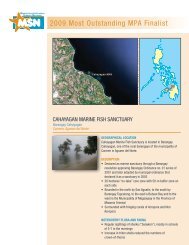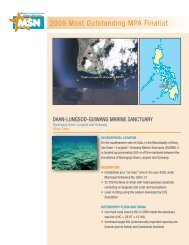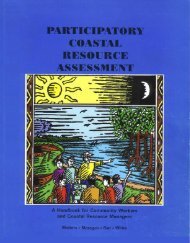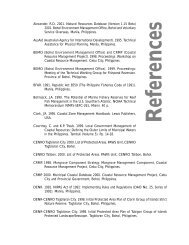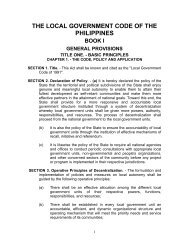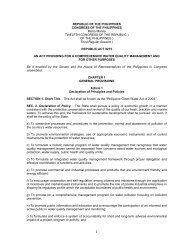Effectiveness of Marine Protected Areas in the Philippines for ...
Effectiveness of Marine Protected Areas in the Philippines for ...
Effectiveness of Marine Protected Areas in the Philippines for ...
Create successful ePaper yourself
Turn your PDF publications into a flip-book with our unique Google optimized e-Paper software.
Weeks et al. 7<br />
Figure 4. Frequency <strong>of</strong> distance<br />
to <strong>the</strong> nearest mar<strong>in</strong>e protected<br />
area (MPA), show<strong>in</strong>g<br />
recommended distances between<br />
MPAs <strong>in</strong> a network designed on<br />
<strong>the</strong> basis <strong>of</strong> predicted larval<br />
dispersal distances taken from<br />
(a) Jones et al. (2008) and (b)<br />
Shanks (2003). All locations are<br />
estimated to be accurate to<br />
with<strong>in</strong> 5 km. Euclidean distance<br />
between MPAs was measured<br />
with <strong>the</strong> Hawth’s analysis<br />
distance between po<strong>in</strong>ts ( Beyer<br />
2004) extension <strong>for</strong> ArcGIS.<br />
<strong>in</strong> no-take MPAs (Table 2). This fails to achieve Fisheries<br />
Code or Philipp<strong>in</strong>e <strong>Mar<strong>in</strong>e</strong> Sanctuary Strategy targets.<br />
To achieve <strong>the</strong> Philipp<strong>in</strong>e <strong>Mar<strong>in</strong>e</strong> Sanctuary Strategy<br />
target <strong>of</strong> 10% <strong>of</strong> coral reef area <strong>in</strong> no-take MPAs, an additional<br />
2030 km 2 <strong>of</strong> coral reef no-take area is required.<br />
If one community-based no-take MPA were established<br />
per coastal barangay, an <strong>in</strong>crease <strong>in</strong> <strong>the</strong> size <strong>of</strong> no-take<br />
MPAs to 0.31 km 2 would be required (Table 2), which is<br />
almost three times larger than <strong>the</strong> current median size.<br />
If <strong>the</strong> maximum historical rate <strong>of</strong> MPA implementation<br />
(97 MPAs per year <strong>in</strong> 2002) were to cont<strong>in</strong>ue, this target<br />
would not be reached until 2076. To meet <strong>the</strong> target by<br />
2020 would require <strong>the</strong> designation <strong>of</strong> at least 545 MPAs<br />
(≥0.31 km 2 )everyyear.<br />
Table 2. Percentage <strong>of</strong> target area protected under different no-take<br />
mar<strong>in</strong>e-protected-area (MPA) scenarios.<br />
1 km Reef<br />
Municipal <strong>of</strong>fshore area b<br />
Scenario a waters (%) (%) (%)<br />
Current 0.48 5.02 1.89 c<br />
Current, plus 1 MPA/coastal 0.27 2.78 7.28<br />
barangay (0.12 km 2 )<br />
Current, plus 1 MPA/coastal<br />
barangay (0.31 km 2 )<br />
1.19 12.2 10.24<br />
a A barangay is <strong>the</strong> smallest political unit with<strong>in</strong> a city or municipal<br />
government.<br />
b Reef area estimate taken from Spald<strong>in</strong>g et al. (2001).<br />
c Accounts <strong>for</strong> <strong>the</strong> reef area only <strong>in</strong> Tubbataha Reef and Apo Reef<br />
MPAs.<br />
Discussion<br />
Our results provide <strong>the</strong> first comprehensive nationalscale<br />
assessment <strong>of</strong> <strong>the</strong> conservation effectiveness <strong>of</strong><br />
MPAs <strong>in</strong> <strong>the</strong> Philipp<strong>in</strong>es. Results <strong>in</strong>dicate that <strong>the</strong> current<br />
extent, distribution, and size <strong>of</strong> MPAs are <strong>in</strong>adequate<br />
to fulfill conservation objectives at this scale.<br />
Although <strong>in</strong>dividual MPAs can achieve local-scale fisheries<br />
objectives (e.g., Alcala & Russ 2006), <strong>the</strong>y do<br />
not constitute a comprehensive national MPA network<br />
that is needed to achieve an adequate representation <strong>of</strong><br />
biodiversity.<br />
We estimated that 0.5% <strong>of</strong> coastal municipal waters<br />
and between 2.7% and 3.4% <strong>of</strong> coral reef area <strong>in</strong> <strong>the</strong><br />
Philipp<strong>in</strong>es are currently protected with<strong>in</strong> no-take MPAs.<br />
This falls well short <strong>of</strong> legislated targets. Although <strong>the</strong>re<br />
is some uncerta<strong>in</strong>ty <strong>in</strong> our estimate <strong>of</strong> <strong>the</strong> extent <strong>of</strong> MPA<br />
coverage as a result <strong>of</strong> sites with miss<strong>in</strong>g spatial <strong>in</strong><strong>for</strong>mation,<br />
this is unlikely to alter our results significantly.<br />
Assign<strong>in</strong>g m<strong>in</strong>imum (0.01 km 2 ), median (0.12 km 2 ), or<br />
mean (0.28 km 2 ) values to sites with miss<strong>in</strong>g size data<br />
resulted <strong>in</strong> a maximum difference <strong>in</strong> estimates <strong>of</strong> 63 km 2<br />
<strong>of</strong> no-take area. This difference is



